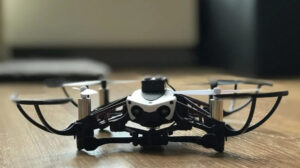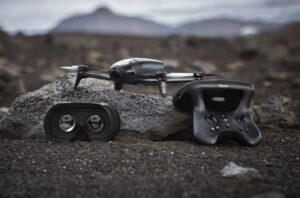In an era where technology is constantly reshaping our daily lives, drones have emerged as one of the most exciting advancements in aerial innovation. Among the leading companies in this field is Parrot, a French company that has carved out a niche in the drone market with a range of products designed for both amateurs and professionals. This article explores the development, technology, and impact of Parrot drones, examining how they have revolutionized the field of unmanned aerial vehicles (UAVs).

The Origins of Parrot Drones
Founded in 1994 by Henri Seydoux, Parrot initially focused on developing wireless technology for mobile phones. However, the company’s direction changed in the early 2010s when it ventured into the world of drones. In 2010, Parrot launched its first drone, the Anafi Drone, which was a significant leap forward in making drones accessible to the general public. The introduction of the Anafi Drone marked a significant moment in the consumer drone market, as it combined advanced technology with user-friendly features, setting a precedent for future innovations.
Key models and their innovations
Anafi Drone series
The Anafi Drone series represented Parrot’s initial foray into consumer drones. The Anafi Drone 1.0, released in 2010, was notable for its use of a smartphone as a controller, leveraging Wi-Fi for connectivity. Its dual camera system – one facing forward and the other downward – provided users with a unique perspective and laid the groundwork for future advancements in drone technology.
The Anafi Drone 2.0, launched in 2012, improved upon its predecessor with a 720p high-definition camera, increased flight stability, and more sophisticated control options. This model solidified Parrot’s reputation as an innovator in the drone industry, demonstrating their commitment to advancing aerial technology.
Bebop Drone Series
The Bebop series marked another important milestone for Parrot. The Bebop drone, introduced in 2014, featured a 14-megapixel camera capable of recording 1080p video. Its design was optimized for improved aerodynamic performance, and it introduced the concept of “virtual reality” flight, where users could experience first-person view (FPV) through the drone’s camera. The Bebop 2, released in 2015, built on this foundation with longer battery life, improved stability, and better overall performance.
The Origins of Parrot Founded in 1994 by Henri Seydoux, Parrot initially developed focus technology for mobile phones. However, the company’s direction changed in the early 2010s when it ventured into the world of immersive drones. In 2010 Parrot launched its first Sunrise, the Anafi drone, which was a significant revolutionary in making flying easier for the general public. Anafi. The introduction of drones has seen a significant future in the consumer market, as advanced technology combined with user-friendly opportunities has brought a vital aspect to innovations.
Anafi Drone Series
The Anafi Series, launched in 2018, showcased Parrot’s advancement in drone technology. The Anafi drone was equipped with a 4K HDR camera and had a unique 180-degree tilt feature, allowing users to capture images and video from unconventional angles. Its lightweight design, combined with advanced flight capabilities make it a favorite among both amateur and professional drone enthusiasts. The Anafi USA, introduced in 2020, further enhanced the series with features tailored for professional applications, including thermal imaging and advanced data capture.

Technological Advancements
Camera Technology
Parrot has made steady advancements in camera technology for drones. The evolution from the basic cameras of the Anafi Drone to the 1080p of the Bebop and the 4K HDR of the Anafi reflects a broader trend toward higher resolution and more flexibility in capturing aerial footage. The integration of high-quality cameras allows users to capture stunning imagery and video content, which is especially valuable for sectors such as filmmaking, surveying, and agriculture.
Flight stability and control
Flight stability has been a major focus for Parrot. Early models such as the Anafi Drone 1.0 used basic stabilization technologies, but later models incorporated more sophisticated systems, including GPS-based stabilization and advanced gyroscopic sensors. These enhancements have contributed to a smoother flight experience, more precise control, and increased reliability, making Parrot drones suitable for a wide range of applications.
Battery life and efficiency
Battery life is a key factor in drone performance. Parrot has made significant progress in extending the operating time of its drones. The Bebop series introduced longer battery life than earlier models, and the Anafi series further improved this aspect with more efficient power management. Extended flight time is important for applications such as aerial surveys and long-term filming, where downtime to change batteries can be a significant barrier.
Applications and use cases
Consumer photography and videography
The most popular use of Parrot drones is in consumer photography and videography. High-quality cameras and stable flight systems enable users to capture breathtaking aerial shots and videos. This capability has changed the way people document their travels, events, and personal experiences, providing a new perspective that was previously difficult to achieve.
Professional Filmmaking
In the professional filmmaking industry, Parrot drones are used to capture dynamic aerial shots that add a cinematic quality to productions. The advanced camera system and stability features of drones like the Anafi USA have made them valuable tools for filmmakers, allowing for creative angles and wider shots that enhance the visual storytelling.
Agriculture and Environmental Monitoring
Parrot drones have found applications in agriculture and environmental monitoring. Equipped with specialized cameras and sensors, these drones can conduct aerial surveys of crops, monitor plant health, and even assess environmental changes. This data is invaluable to farmers and researchers, providing insights that can lead to more informed decisions and efficient practices.
Emergency Response and Public Safety
With its thermal imaging capabilities, Anafi USA is particularly well-suited for emergency response and public safety applications. Firefighters, search and rescue teams, and law enforcement agencies use drones to gain situational awareness, locate individuals, and assess hazardous environments. The ability to see through smoke or darkness using thermal imaging is a game-changer in critical situations.
Challenges and Future Directions
Regulatory and Legal Issues
The rapid proliferation of drones has led to regulatory and legal challenges. Governments around the world are implementing regulations to ensure safe and responsible drone use. Like other drone manufacturers, Parrot must navigate these regulations, which can vary significantly by region. Compliance with privacy laws, airspace restrictions, and safety standards is critical to maintaining operational integrity and public trust.
Technical Limitations
Despite significant advancements, there are still technical limitations that need to be addressed. Battery life, while improved, remains a barrier to extended missions. Additionally, weather conditions and signal interference can impact drone performance. Future development will focus on addressing these limitations to increase the drone’s reliability and versatility.
Market Competition
The drone market is highly competitive, with many companies vying for dominance. Parrot faces competition from major players like DJI as well as emerging startups. To stay ahead, Parrot must continue to innovate and differentiate its products, providing unique features and capabilities that meet the new products being developed.

